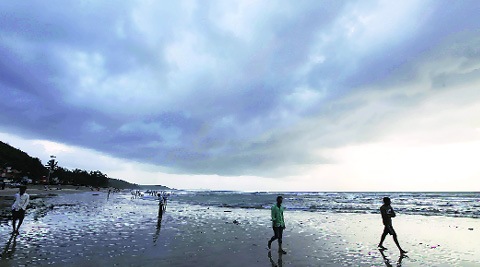Stay updated with the latest - Click here to follow us on Instagram
UN panel nod for project to track marine turtles’ migratory patterns
Committee has approved a Rs 30-lakh proposal of Wildlife Institute of India to track turtles by attaching a Platform Terminal Transmitter.
 The initiative will be in addition to a current study on the population of dolphins in the Arabian sea. ( Source: Express archive )
The initiative will be in addition to a current study on the population of dolphins in the Arabian sea. ( Source: Express archive )
Where do marine turtle hatchlings spend the rest of their lives on leaving the Ratnagiri beaches? The mystery of the little-known life cycle of these marine Cetaceans will soon be unravelled with the recent approval on the satellite tagging of marine turtles. The steering committee of the GOI-United Nations Development Programme (UNDP) project on ‘mainstreaming coastal and marine biodiversity into production sectors in Sindhudurg coast’ had met in Mumbai last week.
The committee has approved a Rs 30.45-lakh proposal of the Wildlife Institute of India to track turtles in the ocean by attaching a Platform Terminal Transmitter to the backs of around 10 turtles. This study will provide insights into the turtles’ migratory patterns and routes, their behaviour at sea, where their marine habitats are located and how turtles use the different habitats.
“We know very little of their habitat and we need to learn more about their breeding and migratory pattern. Once we know which ecosystems they frequent, it will be easier for us to conserve them,” said Dr Subir Ghosh, project coordinator of the GOI-UNDP project.
Four species — Hawksbill sea turtle, Olive Ridley turtles, Leatherback sea turtle and Green sea — are found in Maharashtra. From the 118 sandy beaches surveyed across Thane, Raigad, Ratnagiri and Sindhudurg districts in 2010, 13 beaches were found to have considerable nesting, stated a report titled ‘Marine Turtles Along The Indian Coast – Distribution, Status, Threats and Management Implications’ by the World Wildlife Fund-India in 2013. Around 818 nests were recorded between November 2002 and May 2012 and around 33,080 hatchlings were released into the sea, it stated.
Also, a study to learn the feeding strategies, group dynamics and overall health and survival of the dolphins using Passive Acoustic Monitoring devices was also approved. The study will be in addition to the current study on the population of dolphins in the Arabian sea conducted by the Konkan Cetacean Research Team.
The devices will be placed on a large area of the sea bed and register the number of dolphins and porpoises crossing the area. “Unlike the case with tagging, a large number of dolphins can be recorded. In the case of small dolphins, tagging is not considered safe and cost effective,” Ghosh said. Finless porpoises and Indo-Pacific humpback dolphin are the main species found in the Arabian Sea, he added.
anjali.lukose@expressindia.com








